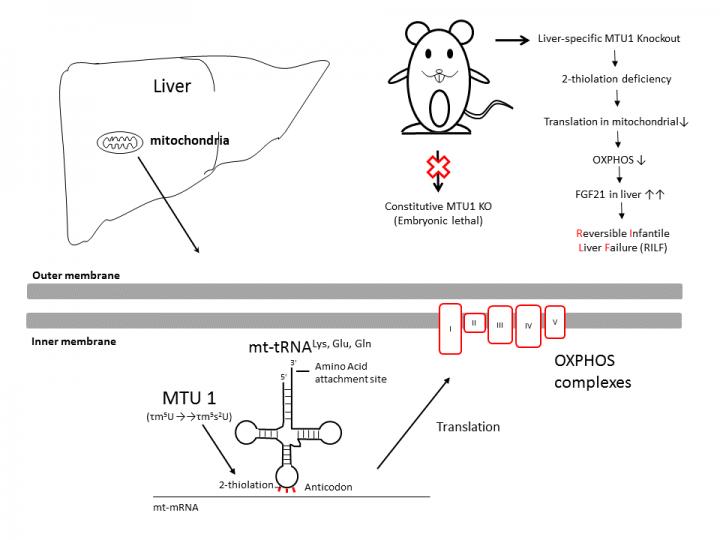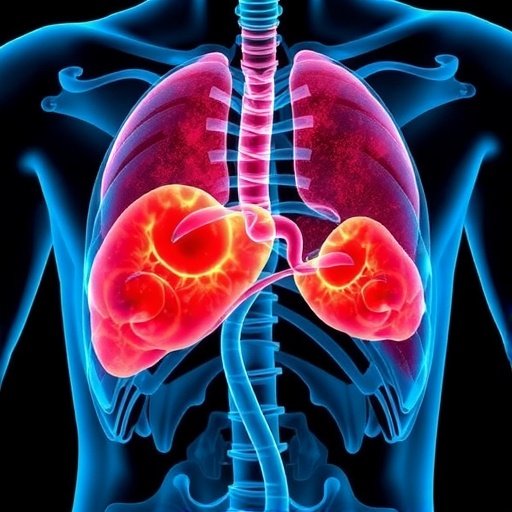
Credit: Professor Kazuhito Tomizawa
Reversible infantile liver failure (RILF) is a heritable mitochondrial condition that causes severe liver dysfunction in infancy, but those who survive the acute stage typically recover and have no further problems. In work designed to examine the molecular mechanisms involved in RILF, researchers in Japan have used a novel murine model to show that a deficiency of the mitochondrial enzyme MTU1 has strong effects on the liver and on embryonic development in general.
The researchers began their look into how MTU1 effects the regulation of mitochondrial protein translation by creating several different lines of MTU1 knockout mice. They quickly found Mtu1 is extremely important for the growth of the mouse embryo. In their attempts at creating the different mouse lines, their experiments showed that wild-type (Mtu1+/+) and heterozygous (Mtu1+/-) mice appeared to develop normally and without any apparent morphological defects. On the other hand, homozygous (Mtu1-/-) knockout mice did not develop beyond about one week after insemination, thereby providing evidence of Mtu1's importance.
To avoid the issue produced by the Mtu1-/- knockout mouse line, the researchers used a conditional gene knockout technique, a technique used to eliminate a specific gene in a certain tissue, to produce a liver-specific knockout mouse (MtuLKO). Like the wild-type and heterozygous mice, this line developed without any apparent external morphological defects. However, there were clear signs of liver damage similar to that found in RILF patients, as well as an altered metabolism; a lack of sulfur-containing modifications in three different mt-tRNAs, which is thought to increase decoding efficiency; a diminished level of mitochondrial protein translation in hepatocytes, showing that Mtu1 is required for mitochondrial translation; and major morphological differences in the mitochondria when compared to the control.
Interestingly, the lack of Mtu1 caused some unique side effect that may explain why many patients with RILF are able to recover from the condition. It is known that fibroblast growth factor 21 (FGF21) is associated with the production of mitochondria, and that its levels in the liver are known to increase as mitochondrial functionality decreases. Because of this, the researchers measured the levels of FGF21 in Mtu1LKO mice and found a large increase compared to the levels found in control mice. Furthermore, the researchers also found a strong antioxidant response in the Mtu1-deficient mouse line. "It appears the combination of mitochondrial production and antioxidant activity is enough to counteract the liver failure found in the Mtu1LKO mouse line," said Professor Kazuhito Tomizawa of Kumamoto University, leader of the research project. "We were able to show that these mice were still alive and thriving after 16 weeks despite their dysfunctional livers. Moreover, many of the specimens even showed signs of recovery as they got older."
It should be noted that there are existing studies with results that are seemingly in contrast with results of this study (Sasarman et al, 2011, Boczonadi et al, 2013). The reason for this is believed to be due to the use of a different animal model in this research; the other studies did not use a liver-specific murine model.
It is believed that the murine model used in this research will also be effective in developing treatments for RILF.
###
[Citation]
Y. Wu, F.-Y. Wei, L. Kawarada, T. Suzuki, K. Araki, Y. Komohara, A. Fujimura, T. Kaitsuka, M. Takeya, Y. Oike, et al., "Mtu1-mediated thiouridine formation of mitochondrial trnas is required for mitochondrial translation and is involved in reversible infantile liver injury," PLoS Genet, vol. 12, no. 9, p. e1006355, 2016. DOI: 10.1371/journal.pgen.1006355
Media Contact
J. Sanderson
[email protected]
http://ewww.kumamoto-u.ac.jp/en/news/
############
Story Source: Materials provided by Scienmag





